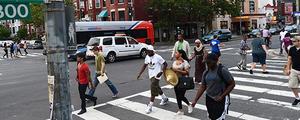People are drawn to cities because of the wide array of opportunities they offer, from employment to education to culture. The vast majority of Americans, approximately 84%, already live in urban areas and, before COVID-19, that percentage was expected to stretch to 89% by 2050.
But with the pressure points of current urban design painfully exposed during the pandemic and recent protests for racial justice, cities will need to transform into more livable, sustainable and affordable environments. If leaders want to build more equitable and just cities, an Urbanova/Gallup study reaffirms they will have to do one thing first: listen.
Current strategies to create "smart cities" that integrate technology into communities to improve wellbeing often ignore the voices of the residents in those communities. Smart city strategies usually start with technology solutions that target ambiguous challenges. These challenges are often identified with little community input, so strategies fail to include the needs of members of various communities, particularly those in underserved groups.
To address the gap between smart city strategies and community needs, Urbanova, a public-private partnership with a focus on midsize cities, created the Neighborhood Impact Initiative. This initiative listens to resident voices to help guide, implement and evaluate interventions to improve people's lives.
Urbanova worked with Gallup to survey residents of Spokane, Washington, where Urbanova is based. Urbanova wanted to pinpoint the relevant problems that residents experience to determine whether technology-based interventions could provide effective solutions to them. Gallup mailed surveys to all 4,366 households in the East Central neighborhood of Spokane to ensure all households were given a voice in identifying the community's biggest challenges and prioritizing them.
This approach provided rigorous measures within hyperlocal areas and provided a nuanced picture of the quality of life, including key outcomes such as resident wellbeing and perceptions of personal safety and environmental quality.
For instance, the official median household income in Census tracts 30 and 32, two geographic subdivisions of Spokane's East Central neighborhood, is roughly the same ($32,297 and $32,545, respectively), but the wellbeing outcomes are drastically different. In tract 32, slightly more than one in four residents (26%) were thriving in at least four of the five wellbeing categories -- purpose, social, financial, community and physical -- compared with just 7% of residents in tract 30.
When residents were asked to evaluate their lives today and in five years, there was also a significant range, confirming the extent of disproportionate outcomes for residents within Spokane's East Central neighborhood. Twenty-nine percent (29%) of residents in tract 145 rated their lives positively enough to be considered "thriving," compared with 51% in tract 31.

Map. This map shows the percentage of residents in the East Central neighborhood of Spokane, Washington, who rated their lives their lives positively enough to be considered thriving by Census tract.
East Central residents also viewed their personal safety and security differently. Overall, 37% of residents said they "strongly agree" or "agree" that they always feel safe and secure in the area where they live. However, there are stark differences underneath. In Census tracts 145 and 30, fewer than one in four residents said they feel safe and secure, while in other areas, such as Tract 31, 50% of residents said they "strongly agree" or "agree" that they are always safe and secure where they live.
Implications for the Future of Urban Planning
The Urbanova/Gallup study of the East Central neighborhood in Spokane illustrates the value of cities taking the time and effort to understand residents' experiences, to ensure smart city solutions will lead to building more just and equitable cities. The unique conditions of midsize cities create an environment conducive to implementing smart city solutions. Midsize cities are neither too small nor too large to conduct bold experiments that are both meaningful and applicable to smaller semiurban and suburban communities.
Midsize cities also represent a microcosm of the challenges facing all cities, such as affordable housing, public safety and income inequality. As midsize cities develop, they are able to learn from the failures of big cities and are in a position to pivot toward smarter and more equitable solutions.
The insights captured from Spokane's residents uncovered disparities that would not have been highlighted by existing datasets. Insights that dive into the hyperlocal situation are essential to prioritizing the allocation of resources to initiatives. They also show that broad-stroke solutions may not be relevant or effective for the acute disparities in smaller pockets within the same neighborhood.
Ultimately, the key is for public- and private-sector leaders to continuously engage with city residents to ensure equitable environments for all residents.




